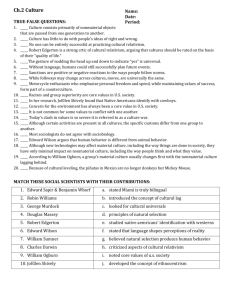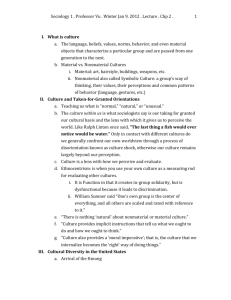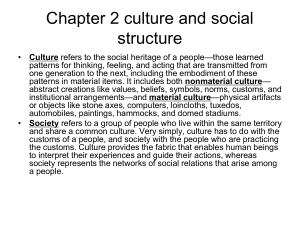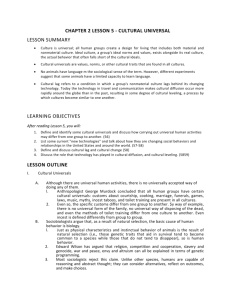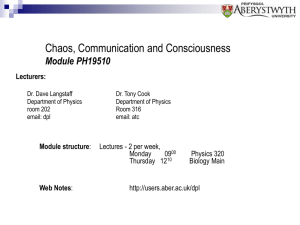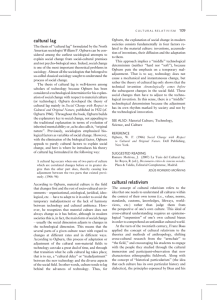Sociology - Culture -Revision
advertisement
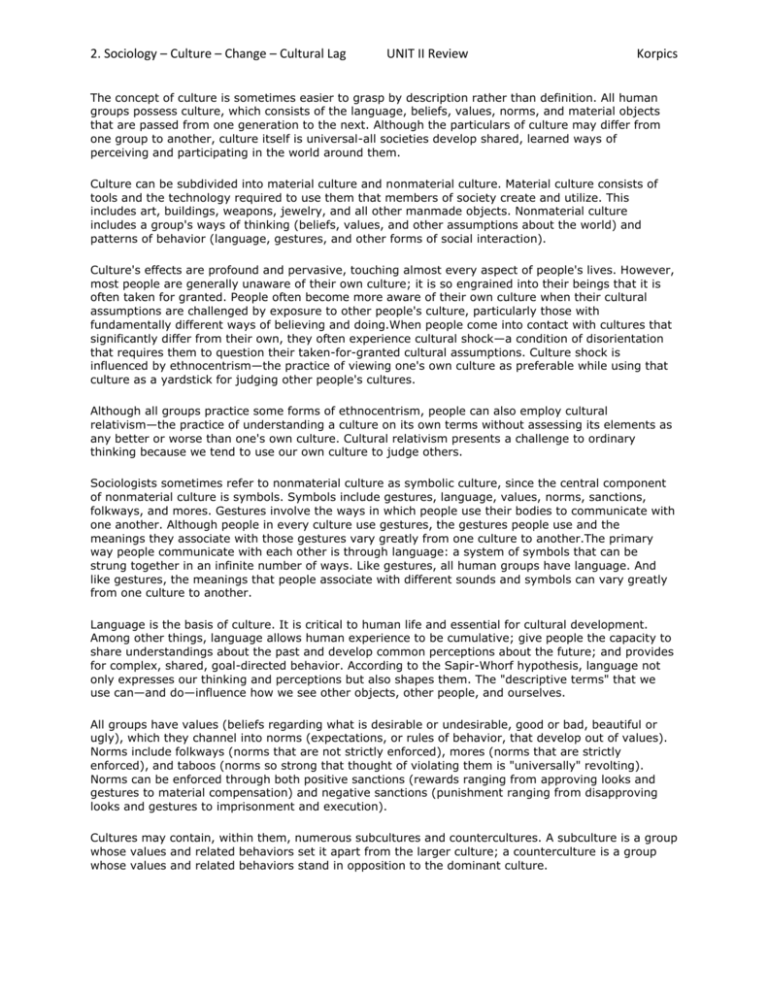
2. Sociology – Culture – Change – Cultural Lag UNIT II Review Korpics The concept of culture is sometimes easier to grasp by description rather than definition. All human groups possess culture, which consists of the language, beliefs, values, norms, and material objects that are passed from one generation to the next. Although the particulars of culture may differ from one group to another, culture itself is universal-all societies develop shared, learned ways of perceiving and participating in the world around them. Culture can be subdivided into material culture and nonmaterial culture. Material culture consists of tools and the technology required to use them that members of society create and utilize. This includes art, buildings, weapons, jewelry, and all other manmade objects. Nonmaterial culture includes a group's ways of thinking (beliefs, values, and other assumptions about the world) and patterns of behavior (language, gestures, and other forms of social interaction). Culture's effects are profound and pervasive, touching almost every aspect of people's lives. However, most people are generally unaware of their own culture; it is so engrained into their beings that it is often taken for granted. People often become more aware of their own culture when their cultural assumptions are challenged by exposure to other people's culture, particularly those with fundamentally different ways of believing and doing.When people come into contact with cultures that significantly differ from their own, they often experience cultural shock—a condition of disorientation that requires them to question their taken-for-granted cultural assumptions. Culture shock is influenced by ethnocentrism—the practice of viewing one's own culture as preferable while using that culture as a yardstick for judging other people's cultures. Although all groups practice some forms of ethnocentrism, people can also employ cultural relativism—the practice of understanding a culture on its own terms without assessing its elements as any better or worse than one's own culture. Cultural relativism presents a challenge to ordinary thinking because we tend to use our own culture to judge others. Sociologists sometimes refer to nonmaterial culture as symbolic culture, since the central component of nonmaterial culture is symbols. Symbols include gestures, language, values, norms, sanctions, folkways, and mores. Gestures involve the ways in which people use their bodies to communicate with one another. Although people in every culture use gestures, the gestures people use and the meanings they associate with those gestures vary greatly from one culture to another.The primary way people communicate with each other is through language: a system of symbols that can be strung together in an infinite number of ways. Like gestures, all human groups have language. And like gestures, the meanings that people associate with different sounds and symbols can vary greatly from one culture to another. Language is the basis of culture. It is critical to human life and essential for cultural development. Among other things, language allows human experience to be cumulative; give people the capacity to share understandings about the past and develop common perceptions about the future; and provides for complex, shared, goal-directed behavior. According to the Sapir-Whorf hypothesis, language not only expresses our thinking and perceptions but also shapes them. The "descriptive terms" that we use can—and do—influence how we see other objects, other people, and ourselves. All groups have values (beliefs regarding what is desirable or undesirable, good or bad, beautiful or ugly), which they channel into norms (expectations, or rules of behavior, that develop out of values). Norms include folkways (norms that are not strictly enforced), mores (norms that are strictly enforced), and taboos (norms so strong that thought of violating them is "universally" revolting). Norms can be enforced through both positive sanctions (rewards ranging from approving looks and gestures to material compensation) and negative sanctions (punishment ranging from disapproving looks and gestures to imprisonment and execution). Cultures may contain, within them, numerous subcultures and countercultures. A subculture is a group whose values and related behaviors set it apart from the larger culture; a counterculture is a group whose values and related behaviors stand in opposition to the dominant culture. 2. Sociology – Culture – Change – Cultural Lag UNIT II Review Korpics Because the United States is a pluralistic society made up of many different groups, competing value systems are common. Some sociologists, however, have tried to identify some underlying core values in the U.S. These core values (values shared by many groups that make up American society) include value clusters (a series of interrelated values that together form a larger whole) and value contradictions (values that contradict one another). Social change often occurs when a society is forced to face, and work through, its value contradictions. Cultural universals are values, norms, or other cultural traits that are found in all cultures. Although anthropologists and sociologists have identified some universal human activities, they have also found that the ways of carrying out these activities differ from one group to another. Technology is central to a group's material culture, while also setting the framework for its nonmaterial culture. The term "new technology" refers to any emerging technologies of an era that have a significant impact on social life. The current "new technology" includes computers, satellites, and various other forms of the electronic media. Cultural lag refers to a condition in which a group's nonmaterial culture lags behind its material culture. With the emergence of new technologies in mass transportation and mass communication, the world is becoming more interconnected. This has resulted in more cultural diffusion (the spread of characteristics from one culture to another) and culture leveling (the process by which cultures become similar to one another). Cultural leveling is occurring rapidly around the world. The Golden Arches of McDonald's, Mickey Mouse, and Fred Flintstone can be found in Miami, Mexico City, Moscow, and in most other major cities of the world. The rapid, far-reaching social change that the world is currently experiencing did not "just happen." It is the result of forces set into motion thousands of years ago. Transforming the course of human history, social change, the alteration of culture and societies over time, is a vital part of social life. When technology changes, societies also change. The primary changes in human history are tied to the four social revolutions: domestication, agriculture, industrialization, and information. The change from Gemeinschaft to Gesselschaft societies; capitalism and industrialization; modernization; and global stratification are other examples of social change that have greatly affected our lives. Social movements, conflict, power, and global politics also contribute to social change. Social change has fascinated theorists. Theories of social change include evolutionary theories (both unilinear and multilinear), cyclical theories, and conflict theories. Unilinear theories assume all societies follow the same paths. Multilinear propose that different routes can lead to the same stage of development. Cyclical theories attempt to account for the rise of entire civilizations.William Ogburn identified technology as the basic cause of social change. According to Ogburn, technology changes society through invention, discovery, and diffusion. Ogburn also coined the term, "cultural lag," to describe how some elements of a culture typically lag behind the changes that come from invention, discovery, and diffusion. Changes in technology often have profound effects on social life. It can significantly change social organization, ideology, values, and social relationships. Not all societal changes are necessarily good. The globalization of capitalism has significantly contributed to environmental decay. The environmental problems of the Most Industrialized Nations include smog, acid rain, the greenhouse effect, and global warming. As the Industrializing and Least Industrialized Nations rush to industrialize, they are also damaging the environment. In many cases, the Industrializing and Least Industrialized Nations have caused even greater damage to the environment than the Industrialized Nations. This is because they lack the pollution controls, anti-pollution laws, and experience in dealing with environmental issues possessed by the Industrialized Nations. Concerns about the environment have sparked a worldwide environmental movement. This movement seeks to protect the environment through education, legislation, and political activism. As a relatively recent subdiscipline of sociology, environmental sociology examines how human activities affect the environment and how the environment affects human activities. Although many environmental sociologists are also environmental activists, the roles do not necessarily overlap. There is a mutual concern, however, for a sense of harmony to be developed between technology and the natural environment 2. Sociology – Culture – Change – Cultural Lag UNIT II Review Korpics

